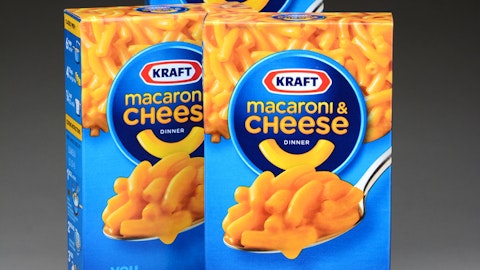Dividend Analysis: Kraft Heinz
We analyze 25+ years of dividend data and 10+ years of fundamental data to understand the safety and growth prospects of a dividend. Kraft Heinz’s dividend and fundamental data charts can all be seen by clicking here.
Dividend Safety Score
Our Safety Score answers the question, “Is the current dividend payment safe?” We look at factors such as current and historical EPS and FCF payout ratios, debt levels, free cash flow generation, industry cyclicality, ROIC trends, and more. Scores of 50 are average, 75 or higher is very good, and 25 or lower is considered weak.
Kraft Heinz’s dividend is very safe. The company’s strong Dividend Safety Score of 89 is driven by its reasonable payout ratio, healthy margins, recession-proof products, and dependable free cash flow. These are some of the most important financial ratios for dividend investing.
Let’s start with the company’s dividend payout ratio. Analysts expect Kraft Heinz to earn $3.07 per share this year, and the company’s annual dividend payout is $2.30 per share.
Dividing the company’s dividend by its projected earnings yields a payout ratio of 74%. While this would be considered a relatively high and potentially risky payout ratio for many types of businesses, it is less of a concern for Kraft Heinz because demand for its products is so stable.
Given the amount of restructuring work and debt refinancing taking place at the company, it’s not a bad idea to look at the company’s projected payout ratio for 2017 as well.
Analysts are estimating that Kraft Heinz will generate $3.82 per share in earnings during 2017. The large increase from 2016 is driven by cost synergies and the company’s refinanced balanced sheet (lower interest expense = higher earnings per share).
If the dividend were to remain at $2.30 per share, the company’s payout ratio would fall to 60% in 2017, which is very healthy for a consumer staples business.
Large food and beverage companies are simply resilient. For example, Heinz has been in business for more than 140 years and grew its sales each year during the last recession. People must continue to eat and drink regardless of how the economy is doing.
Not surprisingly, these companies generate excellent free cash flow. Established brands are cash cows, and Kraft and Heinz both have long track records of generating consistent, growing free cash flow.
Thanks to its stable business model and pricing power, Kraft and Heinz earn high and stable operating margins, which is often the sign of an economic moat.
Heinz in particular is notable because it had the highest profit margins in the industry prior to its combination with Kraft. As Kraft Heinz continues realizing cost synergies from the merger, its strong profitability should be further reinforced.

Source: Simply Safe Dividends
The main knock against the company today is its balance sheet, which maintains a significant amount of leverage and is a critical factor to evaluate when searching for safer stocks.
The company’s net debt / EBIT (earnings before interest and taxes) ratio stands at 5.8x, which means that Kraft Heinz’s total book debt could be covered with cash on hand plus 5.8 years of EBIT. I prefer a much lower ratio (e.g. less than 2.0x for most types of businesses), and it appears that Kraft Heinz agrees.
The company’s management team said it expects to reduce $2 billion of debt by July 2017 to bring its net debt / adjusted EBITDA ratio below 3x over the medium term.
Furthermore, Kraft Heinz is set to reduce its interest expense as early as this summer when it refinances its $8 billion of preferred shares with investment grade debt.
The preferred shares pay Warren Buffett a 9% interest rate ($720 million per year) and originated from the 2013 deal Warren Buffett participated in to take Heinz private with 3G Capital. As part of the deal in 2013, Kraft Heinz could redeem the preferred shares at a premium once three years had lapsed.
Follow Warren Buffett's Berkshire Hathaway
Refinancing the notes will result in higher free cash flow from the interest expense savings, and it’s worth noting the Kraft Heinz still maintains an investment grade credit rating, albeit at the lowest tier possible to remain investment grade.

Source: Simply Safe Dividends
Overall, Kraft Heinz appears to have one of the safest dividends in the market. The company’s payout ratio is healthy and improving, it sells recession-resistant products, free cash flow generation is very consistent, and the balance sheet will look better over the coming years.





